Early Analysis of Landsat-8 Thermal Infrared Sensor Imagery of Volcanic Activity
Abstract
:1. Introduction
2. Thermal Remote Sensing of Volcanic Activity
3. The Landsat-8 TIRS and Volcanic Observations
4. Methods
5. Results
6. Conclusion
Acknowledgments
Conflicts of Interest
References
- Irons, J.R.; Dwyer, J.L.; Barsi, J.A. The next Landsat satellite: The Landsat Data Continuity Mission. Remote Sens. Environ 2012, 122, 11–21. [Google Scholar]
- Irons, J.R.; Dwyer, J.L. An overview of the Landsat Data Continuity Mission. Proc. SPIE 2010, 7695. [Google Scholar] [CrossRef]
- Thome, K.; Reuter, D.; Lunsford, A.; Montanaro, M.; Smith, R.; Tesfaye, Z.; Wenny, B. Calibration of the Thermal Infrared Sensor on the Landsat Data Continuity Mission. Proceedings of 2011 IEEE International Geoscience and Remote Sensing Symposium (IGARSS), Vancouver, BC, Canada, 24–29 July 2011; pp. 985–988.
- USGS. Frequently Asked Questions about the Landsat Missions. 2013. Available online: http://landsat.usgs.gov/band_designations_landsat_satellites.php (accessed on 31 July 2013).
- USGS Landsat Missions. Landsat 8 (L8) Operational Land Imager (OLI) and Thermal Infrared Sensor (TIRS) Calibration Notices. 2014. Available online: http://landsat.usgs.gov/calibration_notices.php (accessed on 25 January 2014).
- Fisher, W.A.; Mozham, R.M.; Polcyn, F.; Landis, G.H. Infrared surveys of Hawaiian Volcanoes. Science 1964, 146, 733–742, (Abstract). [Google Scholar]
- Gawarecki, S.J.; Lyon, R.J.P.; Nordberg, W. Infrared spectral returns and imagery of the Earth from space and their application to geological problems: Scientific experiments for manned orbital flight. Am. Astronaut. Soc. Sci. Tech 1965, 4, 13–33. [Google Scholar]
- Ramsey, M.S.; Harris, A.J.L. Volcanology 2020: How will thermal remote sensing of volcanic surface activity evolve over the next decade? J. Volcanol. Geothermal Res 2012. [Google Scholar] [CrossRef]
- Smith, R.L.; Thome, K.; Richardson, C.; Irons, J.; Reuter, D. Terrestrial Applications of the Thermal Infrared Sensor, TIRS; NASA Goddard Space Flight Center Technical Report 20100003053; NASA: Greenbelt, MD, USA, 2009. [Google Scholar]
- Rothery, D.A.; Francis, P.W.; Wood, C.A. Volcano monitoring using short wavelength infrared data from satellites. J. Geophys. Res 1998, 93, 7993–8008. [Google Scholar]
- Glaze, L.; Francis, P.W.; Rothery, D.A. Measuring thermal budgets of active volcanoes by satellite sensing. Nature 1989, 338, 144–146. [Google Scholar]
- Wooster, M.J.; Rothery, D.A. Thermal monitoring of Lascar Volcano, Chile, using infrared data from the along-track scanning radiometer: A 1992–1995 time series. Bull. Volcanol 1997, 58, 566–579. [Google Scholar]
- Harris, A.J.L.; Flynn, L.P.; Keszthelyi, L.; Mouginis-Mark, P.J.; Rowland, S.K.; Resing, J.A. Calculation of lava effusion rates from Landsat TM data. Bull. Volcanol 1998, 60, 52–71. [Google Scholar]
- Hirn, B.; Di Bartola, C.; Laneve, G.; Cadau, E.; Ferrucci, F. SEVIRI Onboard Meteosat Second Generation, and the Quantitative Monitoring of Effusive Volcanoes in Europe and Africa. Proceedings of 2008 IEEE International Geoscience and Remote Sensing Symposium (IGARSS), Boston, MA, USA, 7–11 July 2008; pp. 374–377.
- Wright, R.; Glaze, L.; Baloga, S.M. Constraints on determining the eruption style and composition of terrestrial lavas from space. Geology 2011, 39, 1127–1130. [Google Scholar]
- Stefan, J. Über die Beziehung zwischen der Wärmestrahlung und der Temperatur. Sitzungsberichte der mathematisch-naturwissenschaftlichen Classe der kaiserlichen Akademie der Wissenschaften 1897, 79, 391–428. [Google Scholar]
- Boltzmann, L. Ableitung des Stefan'schen Gesetzes, betreffend die Abhängigkeit der Wärmestrahlung von der Temperatur aus der electromagnetischen Lichttheorie. Annalen der Physik und Chemie 1884, 22, 291–294. [Google Scholar]
- Planck, M. On the law of distribution of energy in the normal spectrum. Annalen der Physik 1901, 4, 553–563. (In German) [Google Scholar]
- Wien, W. Uber die Energieverteilung in Emissionspektrum eines schwarzen Korpers. Ann. Phys 1896, 58, 662–669. [Google Scholar]
- Wooster, M.J. Small-scale experimental testing of fire radiative energy for quantifying mass combusted in natural vegetation fires. Geophys. Res. Lett 2002. [Google Scholar] [CrossRef]
- Pieri, D.; Abrams, M. ASTER watches the world’s volcanoes: A new paradigm for volcanological observations from orbit. J. Volcanol. Geothermal Res 2004, 135, 13–28. [Google Scholar]
- Ramsey, M.S.; Dehn, J. Spaceborne observations of the 2000 Bezymianny, Kamchatka eruption: The integration of high-resolution ASTER data into near real-time monitoring using AVHRR. J. Volcanol. Geothermal Res 2004, 135, 127–146. [Google Scholar]
- Solikhin, A.; Thouret, J.; Gupta, A.; Harris, A.J.L.; Liew, S. Geology, tectonics, and the 2002–2003 eruption of the Semeru Volcano, Indonesia: Interpreted from high-spatial resolution satellite imagery. Geomorphology 2012, 138, 364–379. [Google Scholar]
- Oppenheimer, C.; Rothery, D.A.; Francis, P.W. Thermal distributions at fumarole fields: Implications for infrared remote sensing of active volcanoes. J. Volcanol. Geothermal Res 1993, 55, 97–115. [Google Scholar]
- Reuter, D.; Richardson, C.; Irons, J.; Allen, R.; Anderson, M.; Budinoff, J.; Casto, G.; Coltharp, C.; Finneran, P.; Forsbacka, B.; et al. The Thermal Infrared Sensor on the Landsat Data Continuity Mission. Proceedings of 2010 IEEE International Geoscience and Remote Sensing Symposium (IGARSS), Hoholulu, HI, USA, 25–30 July 2010; pp. 754–757.
- Markham, B.; Reuter, D.; Montanaro, M.; Lunsford, A.; Barsi, J.; Hook, S.; Schott, S.; Raqueno, N. Landsat-8(formerly LDCM): Mission Update and Thermal Infrared Sensor (TIRS) Initial Post Launch Performance (Abstract). Proceedings of Conference on Characterization and Radiometric Calibration for Remote Sensing (CALCON), Logan, UT, USA, 19–22 August 2013.
- Schott, J.; Gerace, A.; Brown, S.; Gartley, M.; Montanaro, M.; Reuter, D.C. Simulation of image performance characteristics of the Landsat Data Continuity Mission (LDCM) Thermal Infrared Sensor (TIRS). Remote Sens 2012, 4, 2477–2491. [Google Scholar]
- Glovis. USGS Global Visualization Viewer. 2013. Available online: http://glovis.usgs.gov/ (accessed on 31 July 2013).
- Paluweh Volcano (Lesser Sunda Islands, Indonesia): News & Updates. 2013. Available online: http://www.volcanodiscovery.com/paluweh/news.html (accessed on 31 July 2013).
- Harris, A.J.L.; Rose, W.I.; Flynn, L.P. Temporal trends in lava dome extrusion at Santiaguito 1922–2000. Bull. Volcanol 2003, 65, 77–89. [Google Scholar]
- Sahetapy-Engel, S.M.; Flynn, L.P.; Harris, A.J.L.; Bluth, G.; Rose, W.I. Surface temperature and spectral measurements at Santiaguito lava dome, Guatemala. Geophys. Res. Lett 2004, 31, L19610. [Google Scholar]
- Carter, A.J.; Girina, O.; Ramsey, M.S.; Demyanchuk, Y. ASTER and field observations of the 24 December 2006 eruption of Bezymianny Volcano, Russia. Remote Sens. Environ 2008, 112, 2569–2577. [Google Scholar]
- USGS. Using the USGS Landsat 8 Product. 2013. Available online: https://landsat.usgs.gov/Landsat8_Using_Product.php (accessed on 31 July 2013).
- Wan, Z.; Zhang, Y.; Zhang, Q.; Li, Z.L. Validation of the land-surface temperature products retrieved from Terra Moderate Resolution Imaging Spectroradiometer data. Remote Sens. Environ 2002, 83, 163–180. [Google Scholar]
- Harris, A.J.L. Thermal Remote Sensing of Active Volcanoes: A User’s Manual; Cambridge University Press: Cambridge, UK, 2013. [Google Scholar]
- USGS Landsat Missions. Using the USGS Spectral Viewer. 2014. Available online: http://landsat.usgs.gov/instructions.php (accessed on 1 February 2014).
- Barsi, J.A.; Schott, J.R.; Palluconi, F.D.; Hook, S.J. Validation of a web-based atmospheric correction tool for single thermal band instruments. Proc. SPIE 2005. [Google Scholar] [CrossRef]
- Rothery, D.A.; Coltelli, M.; Pirie, D.; Wooster, M.J.; Wright, R. Documenting surface magmatic activity at Mount Etna using ATSR remote sensing. Bull. Volcanol 2001, 63, 387–397. [Google Scholar]
- Murphy, S.M.; de Souza Filho, C.R.; Oppenheimer, C. Monitoring volcanic thermal anomalies from space: Size matters. J. Volcanol. Geothermal Res 2011, 203, 48–61. [Google Scholar] [Green Version]
- Harris, A.J.L.; Dehn, J.; Calvari, S. Lava effusion rate definition and measurement: A review. Bull. Volcanol 2007, 70, 1–22. [Google Scholar]
- Bailey, J.E.; Harris, A.J.L.; Dehn, J.; Calvari, S.; Rowland, S.K. The changing morphology of an open lava channel on Mt. Etna. Bull. Volcanol 2006, 68, 497–515. [Google Scholar] [Green Version]
- Blackett, M. Review of the Utility of Infrared Remote Sensing for Detecting and Monitoring Volcanic Activity with the Case Study of Shortwave Infrared Data for Lascar Volcano from 2001–2005. In Remote Sensing of Volcanoes and Volcanic Processes: Integrating Observation and Modelling; Pyle, D.M., Mather, T.A., Biggs, J., Eds.; Special Publication 380; Geological Society London: London, UK, 2013; pp. 107–135. [Google Scholar]
- Wright, R; Flynn, L.P. A space-based estimate of the volcanic heat flux into the atmosphere during 2001 and 2002. Geology 2004, 32, 189–192. [Google Scholar]
- Justice, C.O.; Giglio, L.; Korontzi, S.; Owens, J.; Morisette, J.T.; Roy, D.P.; Descloitres, J.; Alleaume, S.; Petitcolin, F.; Kaufman, Y. The MODIS fire products. Remote Sens. Environ 2002, 83, 244–262. [Google Scholar]
- Giglio, L.; Descloitres, J.; Justice, C.O.; Kaufman, Y.J. An enhanced contextural fire detection algorithm for MODIS. Remote Sens. Environ 2003, 87, 273–282. [Google Scholar]
- USGS. Landsat 8 Mission Updates. 2013. Available online: http://www.nasa.gov/mission_pages/landsat/main/mission-updates.html (accessed on 17 October 2013).
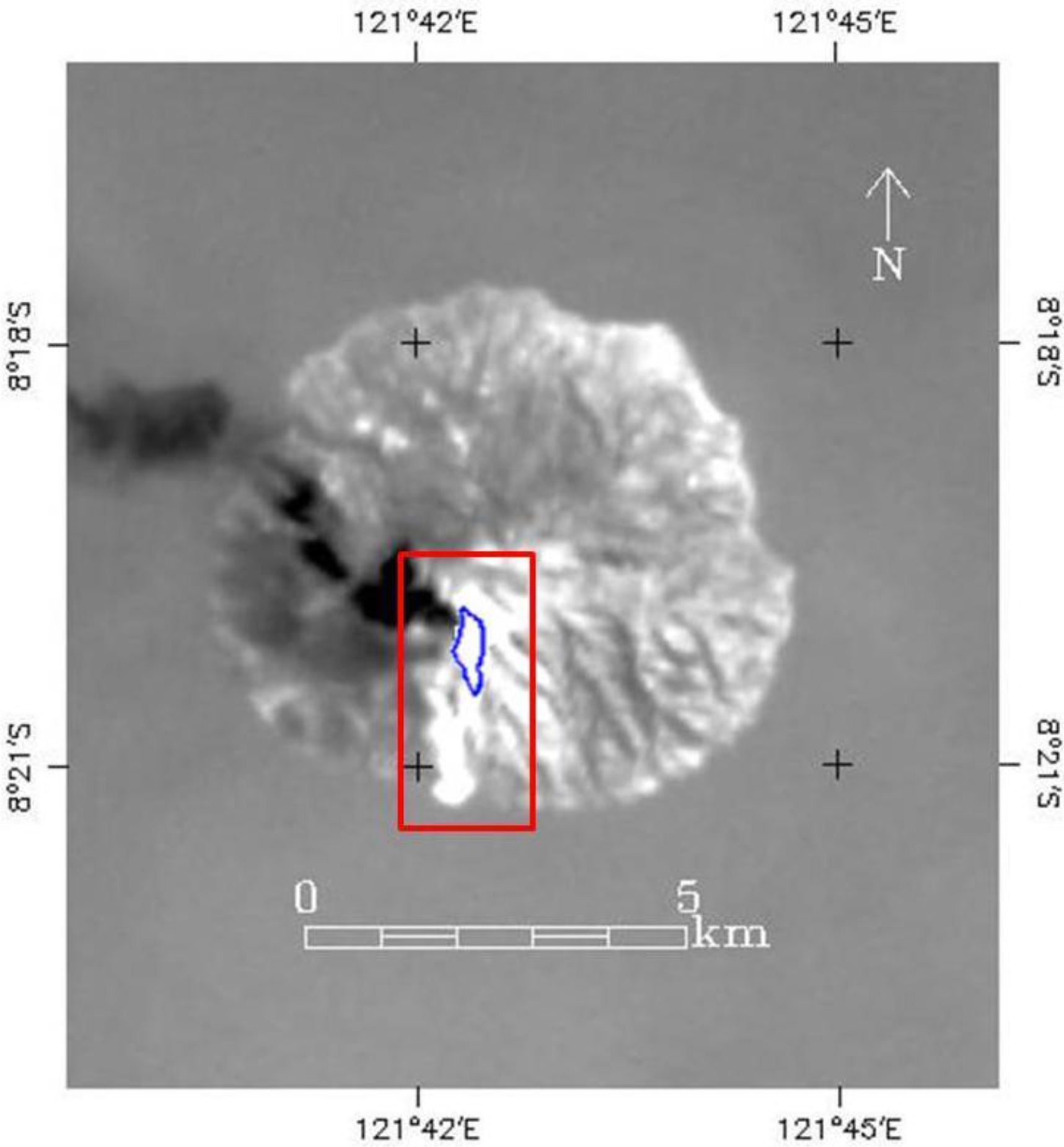
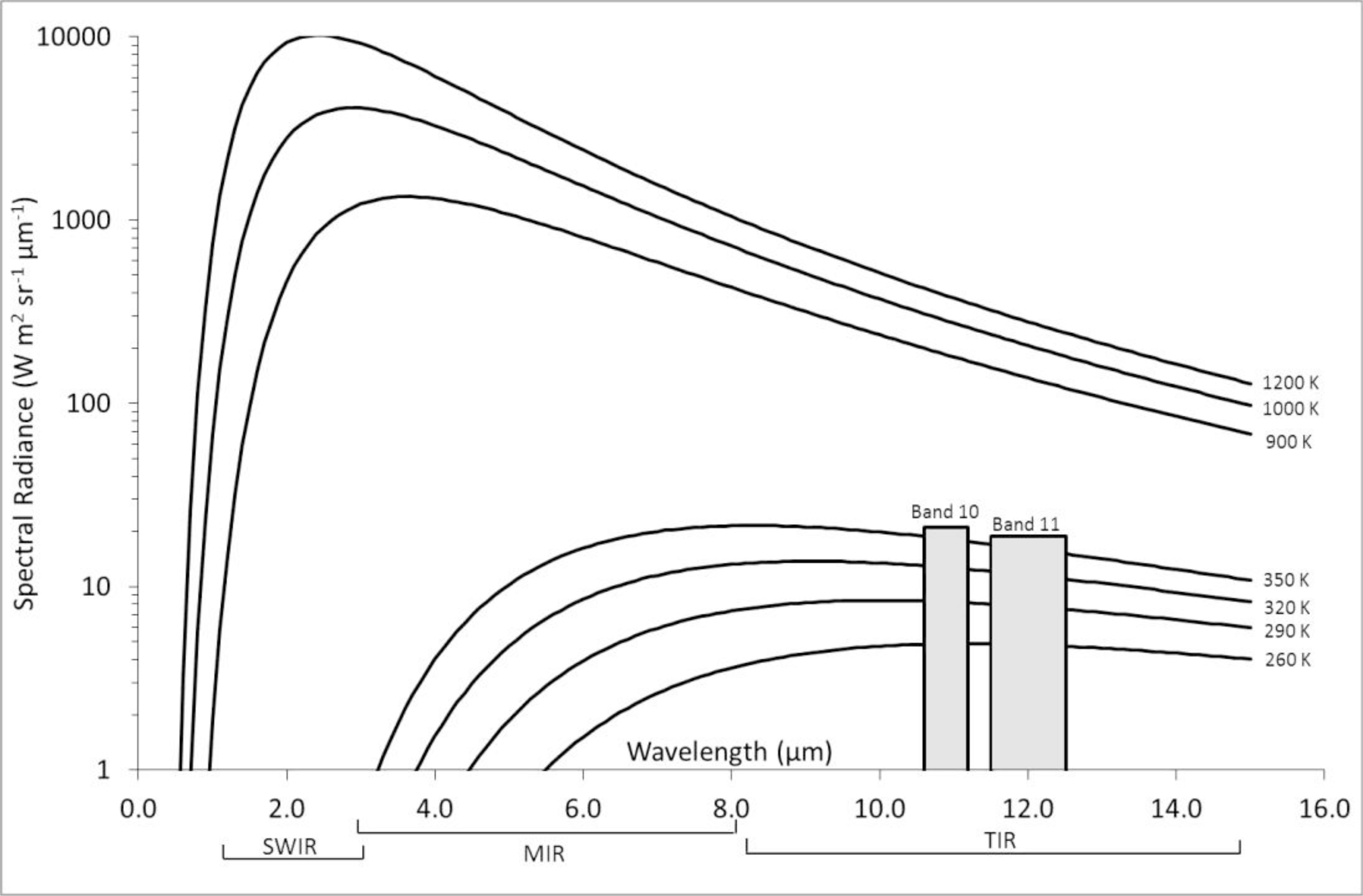
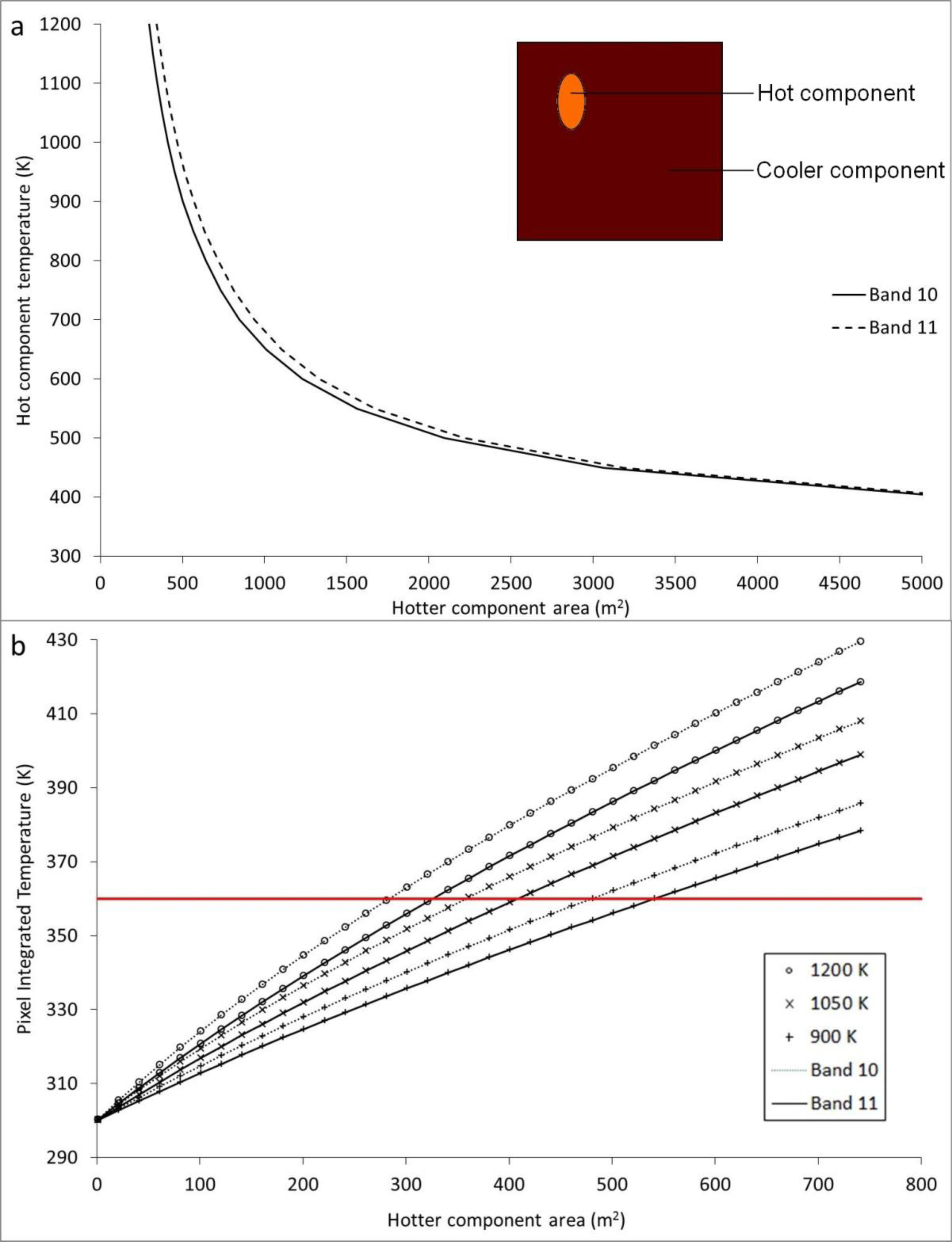
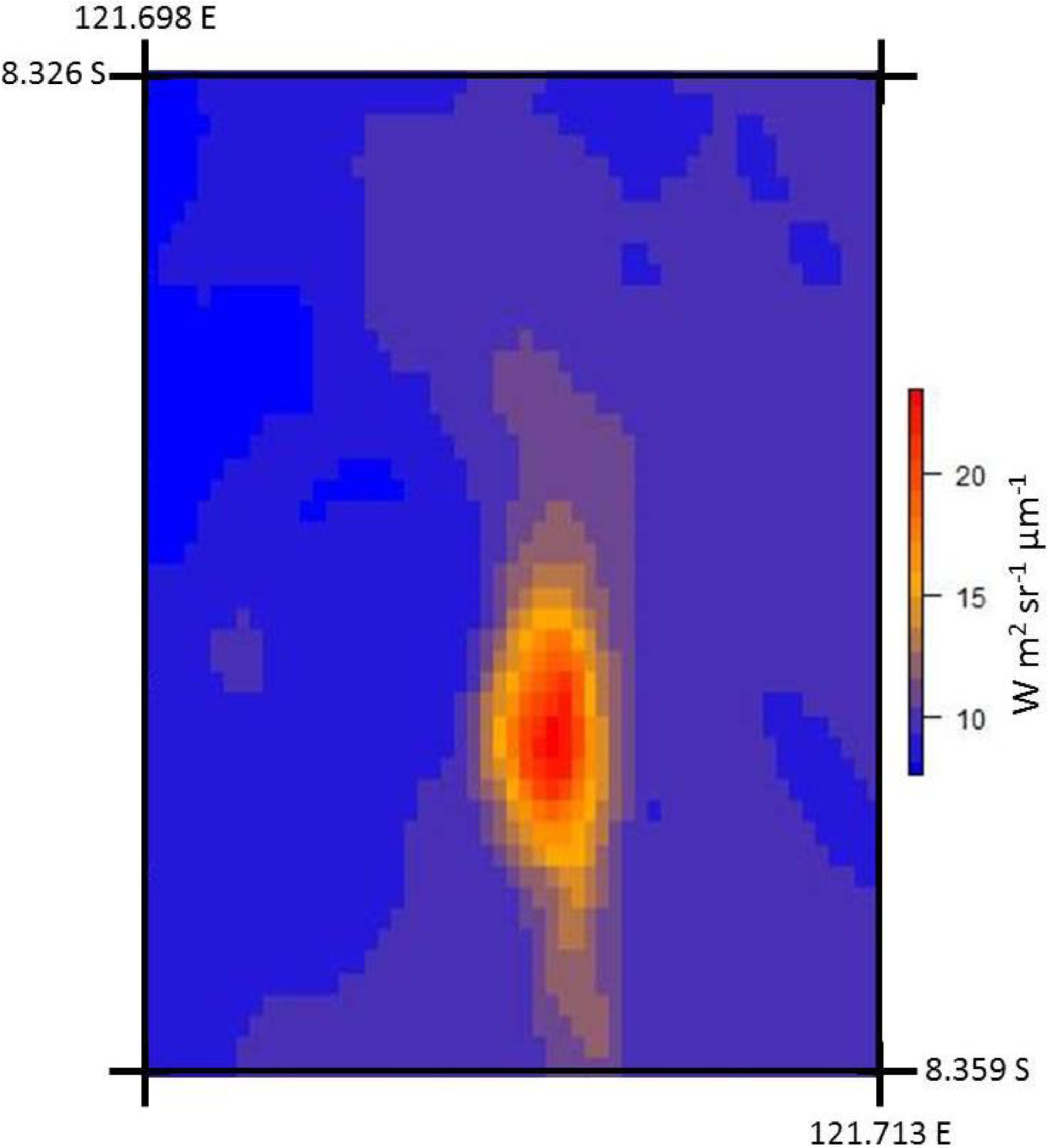
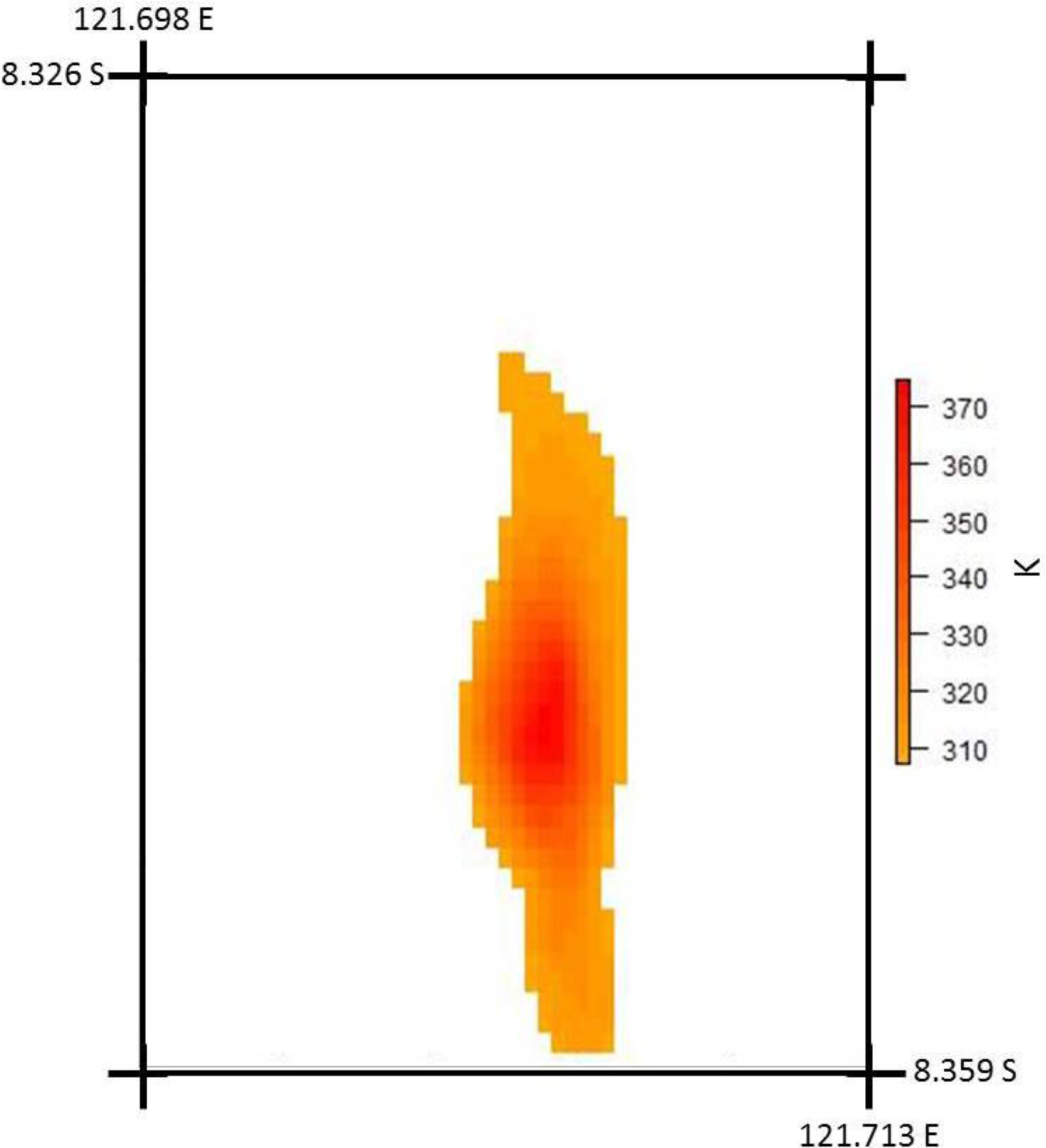
| Instrument | Band | Spectral Range (μm) | Spatial Resolution (m) |
|---|---|---|---|
| OLI | 1 | 0.43–0.45 | 30 |
| 2 | 0.45–0.51 | 30 | |
| 3 | 0.53–0.59 | 30 | |
| 4 | 0.64–0.67 | 30 | |
| 5 | 0.85–0.88 | 30 | |
| 6 | 1.57–1.65 | 30 | |
| 7 | 2.11–2.29 | 30 | |
| 8 | 0.50–0.68 | 15 | |
| 9 | 1.36–1.38 | 30 | |
| TIRS | 10 | 10.60–11.19 | 100 |
| 11 | 11.50–12.51 | 100 | |
© 2014 by the authors; licensee MDPI, Basel, Switzerland This article is an open access article distributed under the terms and conditions of the Creative Commons Attribution license (http://creativecommons.org/licenses/by/3.0/).
Share and Cite
Blackett, M. Early Analysis of Landsat-8 Thermal Infrared Sensor Imagery of Volcanic Activity. Remote Sens. 2014, 6, 2282-2295. https://doi.org/10.3390/rs6032282
Blackett M. Early Analysis of Landsat-8 Thermal Infrared Sensor Imagery of Volcanic Activity. Remote Sensing. 2014; 6(3):2282-2295. https://doi.org/10.3390/rs6032282
Chicago/Turabian StyleBlackett, Matthew. 2014. "Early Analysis of Landsat-8 Thermal Infrared Sensor Imagery of Volcanic Activity" Remote Sensing 6, no. 3: 2282-2295. https://doi.org/10.3390/rs6032282





